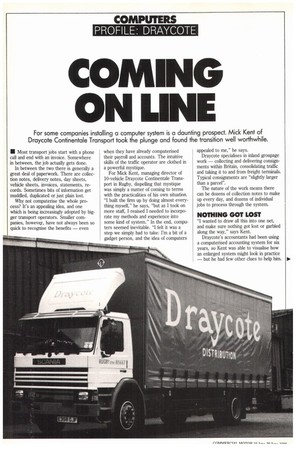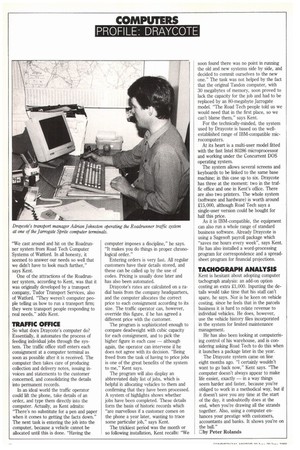COMING ON LINE
Page 42

Page 44

If you've noticed an error in this article please click here to report it so we can fix it.
For some companies installing a computer system is a daunting prospect. Mick Kent of Draycote Continentale Transport took the plunge and found the transition well worthwhile.
• Most transport jobs start with a phone call and end with an invoice. Somewhere in between, the job actually gets done.
In between the two there is generally a great deal of paperwork. There are collection notes, delivery notes, day sheets, vehicle sheets, invoices, statements, records. Sometimes bits of information get muddled, duplicated or just plain lost.
Why not computerise the whole process? It's an appealing idea, and one which is being increasingly adopted by bigger transport operators. Smaller companies, however, have not always been so quick to recognise the benefits — even when they have already computerised their payroll and accounts. The intuitive skills of the traffic operator are clothed in a powerful mystique.
For Mick Kent, managing director of 10-vehicle Draycote Continentale Transport in Rugby, dispelling that mystique was simply a matter of coming to terms with the practicalities of his own situation. "I built the firm up by doing almost everything myself," he says, "but as I took on more staff, I reaised I needed to incorporate my methods and experience into some kind of system." In the end, computers seemed inevitable. "I felt it was a step we simply had to take: I'm a bit of a gadget person, and the idea of computers appealed to me," he says.
Draycote specialises in inland groupage work — collecting and delivering consignments within Britain, consolidating traffic and taking it to and from freight terminals. Typical consignments are "slightly larger than a parcel".
The nature of the work means there can be dozens of collection notes to make up every day, and dozens of individual jobs to process through the system.
NOTHING GOT LOST
"I wanted to draw all this into one net, and make sure nothing got lost or garbled along the way," says Kent.
Draycote's accountants had been using a computerised accounting system for six years, so Kent was able to visualise how an enlarged system might look in practice — but he had few other clues to help him. "We cast around and hit on the Roadrunner system from Road Tech Computer Systems of Watford. In all honesty, it seemed to answer our needs so well that we didn't have to look much further," says Kent.
One of the attractions of the Roadrunner system, according to Kent, was that it was originally developed by a transport company, Tudor Transport Services, also of Watford. "They weren't computer people telling us how to run a transport firm; they were transport people responding to real needs," adds Kent.
TRAFFIC OFFICE
So what does Draycote's computer do? Essentially, it automates the process of feeding individual jobs through the system. The traffic office staff enters each consignment at a computer terminal as soon as possible after it is received. The computer then takes care of producing collection and delivery notes, issuing invoices and statements to the customer concerned, and consolidating the details into permanent records.
In an ideal world the traffic operator could lift the phone, take details of an order, and type them directly into the computer. Actually, as Kent admits: "There's no substitute for a pen and paper when it comes to getting the facts down." The next task is entering the job into the computer, because a vehicle cannot be allocated until this is done. "Having the computer imposes a discipline," he says. "It makes you do things in proper chronological order."
Entering orders is very fast. All regular customers have their details stored, and these can be called up by the use of codes. Pricing is usually done later and has also been automated.
Draycote's rates are calculated on a radial basis from the company headquarters, and the computer allocates the correct price to each consignment according to its size. The traffic operator can, however, override this figure, if he has agreed a different price with the customer.
The program is sophisticated enough to compare deadweight with cubic capacity for each consignment, and to pick the higher figure in each case — although again, the operator can intervene if he does not agree with its decision. "Being freed from the task of having to price jobs is one of the great benefits of the system to me," Kent says.
The program will also display an abbreviated daily list of jobs, which is helpful in allocating vehicles to them and confirming that they have been processed. A system of highlights shows whether jobs have been completed. These details form the basis of historic records which "are marvellous if a customer comes on the phone a year later, wanting to trace some particular job," says Kent.
The trickiest period was the month or so following installation, Kent recalls: "We soon found there was no point in running the old and new systems side by side, and decided to commit ourselves to the new one." The task was not helped by the fact that the original Tandori computer, with 30 megabytes of memory, soon proved to lack the capacity for the job and had to be replaced by an 80-megabyte Jarrogate model. "The Road Tech people told us we would need that in the first place, so we can't blame them," says Kent.
For the technically-minded, the system used by Draycote is based on the wellestablished range of IBM-compatible microcomputers.
At its heart is a multi-user model fitted with the fast Intel 80286 microprocessor and working under the Concurrent DOS operating system.
The system allows several screens and keyboards to be linked to the same base machine; in this case up to six. Draycote has three at the moment: two in the traffic office and one in Kent's office. There are also two printers. The whole system (software and hardware) is worth around 215,000, although Road Tech says a single-user version could be bought for half this price.
As it is IBM-compatible, the equipment can also run a whole range of standard business software. Already Draycote is using a Sagesoft payroll package which "saves me hours every week", says Kent. He has also installed a word-processing program for correspondence and a spreadsheet program for financial projections.
TACHOGRAPH ANALYSIS
Kent is hesitant about adopting computer tachograph analysis: an add-on option costing an extra £1,000. Inputting the details would take time that his staff can't spare, he says. Nor is he keen on vehicle costing, since he feels that in the parcels business it is hard to relate revenue to individual vehicles. He does, however, use the vehicle history files incorporated in the system for limited maintenance management.
He has also been looking at computerising control of his warehouse, and is considering asking Road Tech to do this when it launches a package later in the year.
The Draycote system came on line eight months ago. "I certainly wouldn't want to go back now," Kent says. "The computer doesn't always appear to make life easier, exactly — in a way things seem harder and faster, because you're obliged to work in a methodical way, but if it doesn't save you any time at the start of the day, it undoubtedly does at the end, when you're drawing all the strands together. Also, using a computer enhances your prestige with customers, accountants and banks. It shows you're on the ball."
Eby Peter Rolands
















































































































































